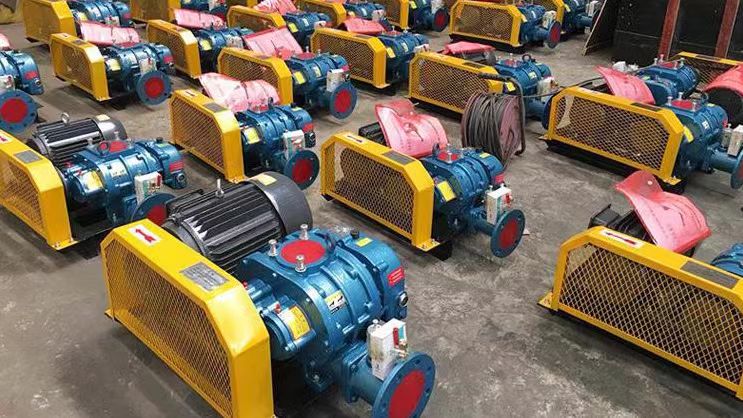 Oxidation Roots blower
Oxidation Roots blower
Oxidation Roots blower, also known as oxidation fan, is a type of positive displacement fan commonly used in environmental protection fields such as sewage treatment and flue gas desulfurization. The following is a detailed introduction about the oxidation Roots blower:
1、 Working principle
The oxidation Roots blower separates the intake and exhaust ports through the "meshing" of a pair of rotors (the gap between the rotors does not contact each other). The rotor is driven by a pair of synchronous gears to rotate in opposite directions at a constant speed, pushing the inhaled gas from the intake port to the exhaust port without internal compression. At the moment when the gas reaches the exhaust port, it is pressurized and transported due to the reflux of high-pressure gas on the exhaust side.
2、 Performance parameters
1. Speed: The number of revolutions per unit time that the active shaft of a Roots blower rotates, known as the fan speed, is the number of revolutions transmitted to the active shaft by the electric motor through gears. The unit of rotation speed is r/min (revolutions per second).
2. Pressure: The gas pressure at the inlet and outlet flanges of a Roots blower, known as intake pressure and exhaust pressure. For Roots blowers, pressure usually refers to static pressure. The commonly used units are bar, kPa, Mpa, and Pa.
3. Boosting: The difference between the inlet and outlet pressure of the blower is called boosting, also known as pressure difference.
4. Flow rate: The mass or volume of gas passing through a specified section of a fan per unit time is called the mass or volume flow rate of gas passing through that section. The nominal flow rate on the product sample and nameplate is the volumetric flow rate under specific conditions.
5. Shaft power: The power transmitted from the prime mover to the main shaft of a Roots blower per unit time under flow rate and head is called the shaft power of the Roots blower. When the blower is equipped with a motor, a margin needs to be left. The commonly used units are W (watts) and KW (kilowatts).
6. Inlet and exhaust temperature: The gas temperature at the flange of the intake and exhaust ports of a Roots blower is called the inlet temperature and exhaust temperature. The difference between the intake and exhaust temperatures is called temperature rise.
3、 Main purpose
Oxidation Roots blower is mainly used in the following fields:
1. Wastewater treatment: An aeration system used in wastewater treatment plants to provide oxygen to accelerate the growth and reproduction of microorganisms, thereby removing organic matter and pollutants from wastewater.
2. Flue gas desulfurization: In the flue gas desulfurization system, the oxidation Roots blower is used to provide oxidizing air, promote the oxidation reaction of sulfur dioxide, and generate harmless substances such as sulfates.
3. Aquaculture: Providing sufficient oxygen to the water in ponds or tanks to ensure the normal growth and reproduction of aquatic organisms.
4. Pneumatic conveying: a technology that utilizes the pressure or velocity difference of gas to suspend and transport material particles in pipelines.
4、 Usage and maintenance
1. Installation environment: It should be installed in a dry and well ventilated place, avoiding direct sunlight and humid environment, to ensure the normal operation of the blower.
2. Regular inspection: Regularly inspect various components of the blower, such as impellers, bearings, gears, etc., to ensure their normal operation. If there is any damage, it should be replaced in a timely manner.
3. Lubrication and maintenance: Lubricate and maintain the blower according to the specified time and requirements to ensure good lubrication of bearings and other components and reduce wear.
4. Cleaning and filtering: Regularly clean the air filter to prevent dust and debris from entering the interior of the blower and affecting its performance.
5. Temperature control: Pay attention to the operating temperature of the blower and avoid prolonged high-temperature operation to prevent damage to components.
6. Stable pressure: Keep the outlet pressure of the blower stable to avoid damage to the equipment caused by excessive pressure fluctuations.
In summary, the oxide Roots blower plays an important role in fields such as environmental protection and aquaculture due to its unique working principle and superior performance parameters. During use, attention should be paid to issues such as installation environment, regular inspections, lubrication and maintenance to ensure stable and smooth operation.





